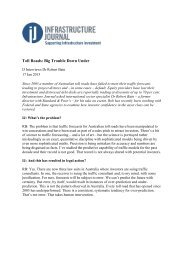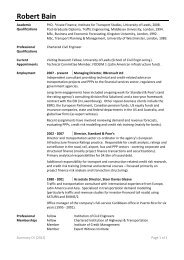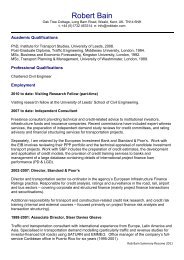Disincentivising overbidding for toll road concessions
Disincentivising overbidding for toll road concessions
Disincentivising overbidding for toll road concessions
- No tags were found...
Create successful ePaper yourself
Turn your PDF publications into a flip-book with our unique Google optimized e-Paper software.
DISINCENTIVISING OVERBIDDING FOR TOLL ROAD CONCESSIONS<br />
Box 3.2 Portuguese SCUTs: a lesson in unaf<strong>for</strong>dability<br />
The following case study considers the ‘SCUT’ programme of PPP <strong>road</strong> <strong>concessions</strong> in Portugal. Although the<br />
payment mechanism was based on the concept of shadow <strong>toll</strong>s (with deductions <strong>for</strong> non-availability), the salient<br />
feature is that, in common with pure availability-based constructs, state payments rather than user charges<br />
<strong>for</strong>med the basis of concessionaire reimbursement. SCUT, Sem Custos para os UTilizadores, means no cost<br />
to the users. The programme became unsustainable and the Portuguese PPP <strong>road</strong>s sector is currently being<br />
re<strong>for</strong>med as a result.<br />
In 1996/97 the Portuguese Government initiated a major programme of motorway construction to improve<br />
accessibility and promote regional development. A highway concession model was employed using the shadow<br />
<strong>toll</strong>-based payment mechanism. However, this placed future financial obligations on the Portuguese state which,<br />
because of the scale of the programme, became unsustainable in aggregate. In the early years, government<br />
payments to SCUT concessionaires represented 0.04% of GDP, but step-ups in the financing documents saw this<br />
increase tenfold, to 0.4% in 2008 (representing about €700m/year). This was a major commitment to one small<br />
part of the economy which the government, even be<strong>for</strong>e the recent economic crisis, simply could not af<strong>for</strong>d. The<br />
government is currently engaged in the long and difficult process of converting a number of the SCUT highways to<br />
regular user-paid <strong>toll</strong> <strong>road</strong>s. 88<br />
Was the Portuguese PPP <strong>road</strong> concession programme a success On one level ‘yes’. Today Portugal has<br />
a motorway network that, given the timescale involved, could not have been envisaged under traditional<br />
contracting arrangements. However, like some other countries, it found that overambitious PPP programmes<br />
with their not inconsiderable future financing obligations (mortgage payments) place severe constraints on<br />
future public sector budgets. This has also been the case in Spain, where the credit rating of the Autonomous<br />
Community of Madrid is currently on negative outlook because PPP debt now accounts <strong>for</strong> around two-thirds of<br />
all spending. It has also been the case in the UK to some extent.<br />
The Highways Agency’s shadow <strong>toll</strong> PPP <strong>road</strong>s programme represents 17% of the UK motorway network, yet PPP<br />
payments account <strong>for</strong> around 40% of the Agency’s budget—meaning that there will be no more shadow <strong>toll</strong> PPP<br />
<strong>road</strong>s procured by the UK Highways Agency.<br />
Several North American jurisdictions had encountered exactly this same issue. In some cases (eg, New Jersey),<br />
entire departmental budgets have become devoted to servicing the payment obligations of infrastructure<br />
projects procured under, effectively, hire purchase-type agreements. Most recently, the UK’s Department of<br />
Health has stepped in to provide financial support to seven NHS trusts facing ‘financial issues’ and ‘a £60 billion<br />
post-dated cheque to deal with’, 89 stemming from its long-term commitments to availability-based PPP hospitals.<br />
The lesson to be learned is that, even when individual PPPs look like offering good value <strong>for</strong> money, the issue<br />
of aggregate af<strong>for</strong>dability, now and in the future, should remain a key concern <strong>for</strong> finance ministries and public<br />
sector policy-makers.<br />
3.2 Pass-through <strong>toll</strong>s<br />
Under a pass-through <strong>toll</strong>ing regime, user <strong>toll</strong>s are levied by the concessionaire, but the payments are <strong>for</strong>warded<br />
directly to the concession grantor (they ‘pass through’ the concessionaire) and, separately, the concessionaire is<br />
reimbursed by the grantor based on asset availability or some other per<strong>for</strong>mance metric(s). 90<br />
When users are paying <strong>for</strong> a service (using a <strong>toll</strong> <strong>road</strong>) <strong>for</strong> which a private operator requires payment (investment<br />
compensation), it may be easy to presume that the user charges should simply flow directly to that operator. Through<br />
history this has been the dominant operator-reimbursement model. However, there is no reason why this should be<br />
adhered to. Indeed, there are a number of reasons why de-linking user charges from operator compensation might be<br />
a preferable approach.<br />
88 This is particularly challenging. Highways designed as <strong>toll</strong>-free facilities commonly promote access, whereas access control is a key element of<br />
<strong>toll</strong> <strong>road</strong> design.<br />
89 The Guardian (2012), Andrew Lansley, UK Health Secretary, February 3rd.<br />
90 Rather confusingly, in the USA ‘pass-through <strong>toll</strong>s’ typically refer to the type of shadow <strong>toll</strong>ing arrangement described earlier. For this reason<br />
readers are advised to check the terminology applied and definitions used in any American <strong>toll</strong> <strong>road</strong> literature.<br />
34






